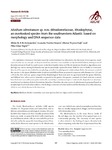"Alsidium oliveiranum" sp. nov. (Rhodomelaceae, Rhodophyta), an overlooked species from the southwestern Atlantic based on morphology and DNA sequence data

Use este enlace para citar
http://hdl.handle.net/2183/24143
Excepto si se señala otra cosa, la licencia del ítem se describe como Atribución-NoComercial 3.0 España
Colecciones
- Investigación (FCIE) [1228]
Metadatos
Mostrar el registro completo del ítemTítulo
"Alsidium oliveiranum" sp. nov. (Rhodomelaceae, Rhodophyta), an overlooked species from the southwestern Atlantic based on morphology and DNA sequence dataFecha
2019Cita bibliográfica
Guimarães, SMPB., Soares, LP., Fujii, MT. & Díaz-Tapia, P. 2019. Alsidium oliveiranum sp. nov. (Rhodomelaceae, Rhodophyta), an overlooked species from the southwestern Atlantic based on morphology and DNA sequence data. Algae. 34:187–198.
Resumen
[Abstract] The exploration of seaweed diversity in poorly studied habitats has often led to the discovery of new species. Sand-covered rocks are an example, as they received less attention than sand-free rocky intertidal habitats during seaweed diversity surveys in Brazil. In sand-covered rocks from Espírito Santo and Rio de Janeiro we found an alga whose morphology was unique among rhodomelacean species previously reported in Brazil. With the aim to clarify the taxonomic identity of this species we studied its morphology, as well as its phylogenetic relationships. Molecular analyses resolved this species in the genus Alsidium (tribe Alsidieae) and differed from sequenced congeners with divergences ≥2.5 and 4.2% in the rbcL and cox1 genes, respectively. Morphological characters were in agreement with the genus Alsidium, and differed from other species currently recognized in the genus. The species consisted of a basal crust and scarcely branched erect axes with seven pericentral cells covered by a continuous layer of cortical cells. Reproductive structures were formed on clusters of short determinate branches. Therefore, the new species A. oliveiranum is proposed based on morphological and molecular evidence. Our findings contribute to better understand the diversity of the tribe Alsidieae, which is particularly diverse in the Americas.
Palabras clave
Alsidieae
Brazil
Ceramiales
cox1
New species
rbcL
Red algae
Sand-covered rocks
Brazil
Ceramiales
cox1
New species
rbcL
Red algae
Sand-covered rocks
Versión del editor
Derechos
Atribución-NoComercial 3.0 España
ISSN
1226-2617
2093-0860
2093-0860






